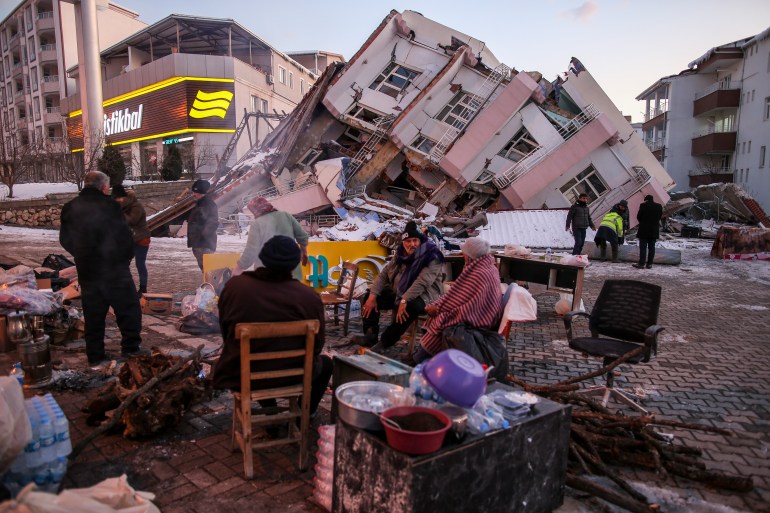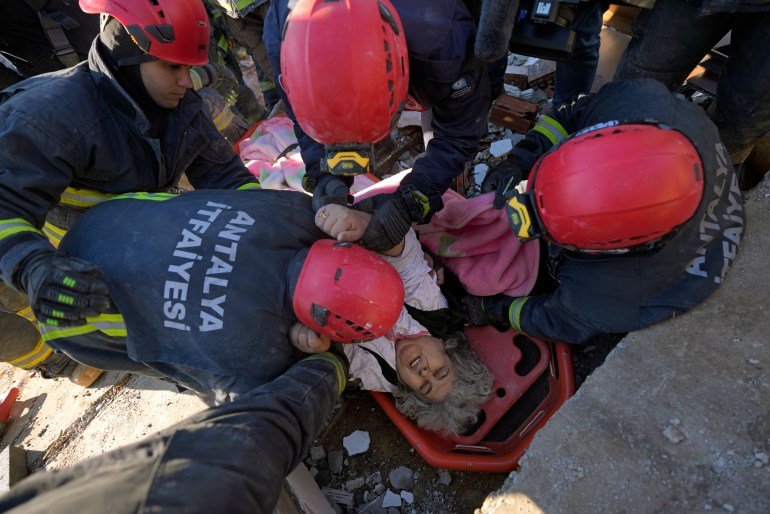“We are searching for my niece, Rukiye,” a tired-looking man with bloodshot eyes instructed native reporters as he peered by means of the twisted stays of a hospital within the southern Turkish province of Hatay on Wednesday.
“She is 23, a nurse. She entered the hospital hours after the first earthquake to help evacuate patients. The building collapsed on her when the second earthquake hit. She saved so many, but couldn’t get out herself. We know she was alive for at least 16 hours – she called her husband from under the rubble. But now the rescuers say she is likely gone.”
1000’s of individuals like Rukiye are believed to nonetheless be caught within the particles of collapsed buildings throughout Turkey’s southeast following Monday’s devastating earthquakes. Based on the federal government, two main tremors and a whole bunch of aftershocks destroyed at the very least 6,444 buildings throughout 10 provinces, killing greater than 12,800 individuals as of Thursday afternoon.
A tragic mixture
As rescuers proceed to look by means of the rubble searching for miracles, the nation is now making an attempt to know why this pure catastrophe – for which Turkey was supposedly getting ready for greater than 20 years – brought on a lot injury to the nation’s infrastructure.
Was it that the 2 earthquakes – the primary at a magnitude of seven.8 and the second at 7.6 – have been just too violent for many buildings to outlive? Or that the buildings have been less than fashionable development requirements? Was there negligence on the a part of the authorities?

Based on Professor Okan Tuysuz, a geological engineer from Istanbul Technical College, a tragic mixture of the entire above led to Monday’s disaster.
“We are dealing with truly massive earthquakes here,” Tuysuz instructed Al Jazeera. “The first one was roughly equivalent to the energy release from an explosion of about 5 million tonnes of TNT. The second was equivalent to 3.5 million tonnes. Most buildings would struggle to withstand such force.”
Sinan Turkkan, civil engineer and president of Turkey’s Earthquake Retrofit Affiliation, agreed. “Not only were the earthquakes extremely forceful, but they also hit in quick succession,” he defined. “Many buildings only received light to medium damage in the first quake but collapsed after the second one.”
Whereas factoring in that tremors at these magnitudes in fast succession would pose a threat to any constructing, consultants underlined {that a} tragedy on this scale was not in any means inevitable.
“According to official estimates, 6,000 to 7,000 buildings collapsed on Monday. However strong, no earthquake could have caused this much damage if all buildings were up to standard,” Turkkan stated.
On Wednesday, Turkey’s President Recep Tayyip Erdogan defended his authorities’s preparations for and response to the earthquakes throughout a go to to the catastrophe zone, saying it was “impossible for anyone to prepare for the scale of the disaster”.
He then went on to say that the state will rebuild all collapsed buildings in all 10 provinces affected by the earthquake inside a yr.
“Just like we did in Malatya, Elazig, Bingol, Van [we will rebuild here]. This is a business we know well. Our government proved its ability [to rebuild] time and time again in the past. We will achieve the same in Hatay, in Maras and also in eight other affected provinces”.
Many of the buildings that collapsed on Monday have been constructed earlier than 1999, when a magnitude 7.6 earthquake hit the Western Marmara area, killing 17,500 individuals. Since then, the federal government improved the Turkish seismic design code considerably and in 2008, launched into an bold city transformation undertaking to organize Turkey for the following large earthquake.
Code enforcement
In November 2022, after a magnitude 6 earthquake broken greater than 2,000 buildings in Duzce, northern Turkey, surroundings and urbanisation minister Murat Kurum underlined that the authorities have been working in direction of making each constructing within the nation “earthquake safe by 2035”.
“We already rebuilt 3.2 million residences,” Kurum stated in a social media publish. “250,000 residences across 81 provinces and 992 districts are currently being transformed [to meet current regulations]. 6.6 million houses and businesses have been audited. 24 million of our citizens are currently living in earthquake-safe abodes.”
These bold efforts, nonetheless, weren’t capable of forestall the catastrophe.
“On paper, Turkey’s seismic design code is up to global standards – it is actually better than most,” Turkkan stated. “In practice, however, the situation is very different.”

The federal government supplied monetary incentives however didn’t make participation in its city transformation undertaking obligatory. This successfully meant solely individuals who have been able to generate profits from rebuilding – individuals in possession of invaluable plots appropriate for additional improvement – agreed to demolish their previous properties and rebuild in accordance with the most recent code. Many didn’t need to spend cash on rebuilding work or reinforcements that didn’t appear pressing. That is why, consultants say, greater than 20 years after the Marmara earthquake, Turkey is stuffed with buildings constructed utilizing sub-par supplies and long-discredited development strategies that instantly crumble when confronted with a powerful tremor.
“This saddens me deeply as an engineer,” Turkkan stated. “If we managed to get everyone on board, we could have either reinforced or rebuilt all defective buildings in the past 20 years. We could have saved at least 5,000 of the buildings that we lost on Monday from complete destruction. We could have saved many, many lives.”
Consultants imagine the federal government and native authorities might have taken additional precautions to make sure all buildings have been protected and earthquake design laws are being applied in all contexts.
“For years we held conferences, wrote reports and sent them to local authorities. We told them big earthquakes will inevitably hit cities like Hatay and Gaziantep again,” Tuysuz stated. “We explained to them however strong, no building built directly on a fault line can survive an earthquake – it would be torn apart. We said we should create accurate fault-line maps for the entire country and transform areas directly on active fault lines into green zones with construction bans. No one listened.”
Even new buildings have been missing
There have been additionally shortcomings in guaranteeing laws have been being adopted in new development.
“Some relatively new buildings also collapsed in this earthquake, which likely means contractors took shortcuts, tried to economise using sub-par materials and authorities failed to do their due diligence before approving construction projects,” Tuysuz stated.
A number of faculties, administrative buildings, hospitals and even the headquarters of Turkey’s Catastrophe and Emergency Administration Authority (AFAD) in Hatay additionally collapsed on Monday.
“According to the state’s own regulations, public buildings are supposed to be much stronger than private ones,” Turkkan defined. “When you are building a hospital, a post office or any other public building, you are instructed to use more concrete, more iron, get more detailed ground studies. This is to ensure those buildings survive any earthquake or other natural disaster and so that they can continue serving people at a time of crisis”.
Tuysuz agreed. “It is completely unacceptable for a public building, a power plant or an airport to collapse in an earthquake,” he stated. “There are very strict regulations in place to prevent this. The scenes we are witnessing today in the southeast are proof of the state’s shortcomings in implementing its own rules even in constructions over which it has complete control.”
So what must be finished?
There are some 20 million buildings in Turkey. In Istanbul, the place consultants imagine a serious earthquake will hit eventually, there are 1.2 million, in accordance with the Kandilli Observatory and Earthquake Analysis Institute at Bogazici College. Their consultants imagine a big share of those buildings usually are not in a situation to face up to tremors at excessive magnitudes.
Reinforcing or rebuilding all at-risk buildings in all earthquake-prone areas can be technically and logistically tough and dear. But it’s a process that can not be averted or delayed.
“The government needs to be more forceful in making people get their buildings audited, reinforced and if necessary rebuilt,” Turkkan stated. “Persons are understandably not volunteering to pay up, however this can be a matter of life and loss of life, and it needs to be handled as such.
#worldnews
